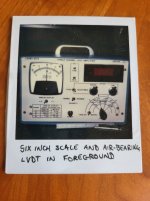After reading the datasheets from AD and considering the matter, an STM32F429I Discovery board looks as if it is the best option for a permanent lab instrument. I have one on hand I bought for under $20 when they first appeared. They're now $30. That's about 1/2 the cost of the AD chips.
It's got 3x 12 bit 2.4 MSa/s ADC, a touch screen display and at 180 MHz quite a bit of floating point capacity. It will oversample 1000 to 1 which adds another 10 bits of resolution. I'm not already using it for something because I killed my development system with ESD :-( I've had a lot of trouble getting motivated to do all that work over.
I want a computer to handle linearity, temperature and device variability corrections even if I use one of the AD analog chips. But I don't need the analog chip to process the data. I am very familiar with DSP.
When I started the thread I was hoping someone might have a schematic for a commercial unit or able to describe how various commercial models are implemented. I try to avoid reinventing wheels, especially complex ones. Though this is not close to what I would call "complex". I still try to examine prior art before building something. It's pretty much reflexive.
This post has evolved over much of the afternoon as I went around doing other things. At this point, despite preceding statements about the STM32, I think the most useful thing to do is to make a buffer board to use with a sound card and write the bit of software that needs. The sole obstacle is how do I R/W the sound card on Debian? The reason for choosing that is it's the minimal effort to replicate. Make a board with some op amps, download the software, calibrate the system. Done! That would make LVDTs and RVDTs much more usable for most people. For whom 10 millionths would be "good enough".
FWIW "synchronous demodulation" is a commutating detector for removing the carrier frequency. There are a lot of variations in the family. Enough to justify an MSEE thesis! Nothing special about the process, just the application.



